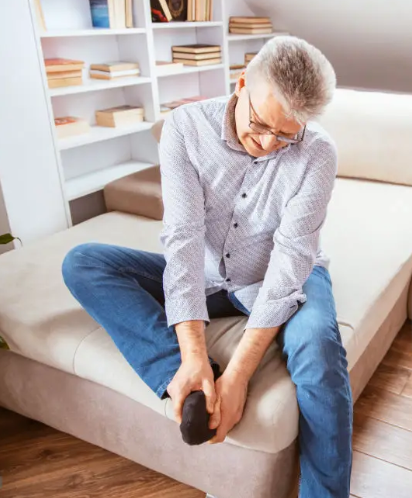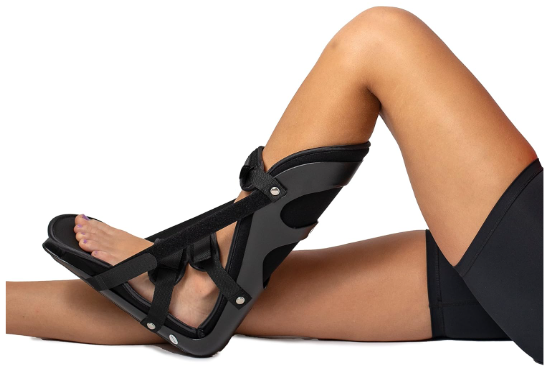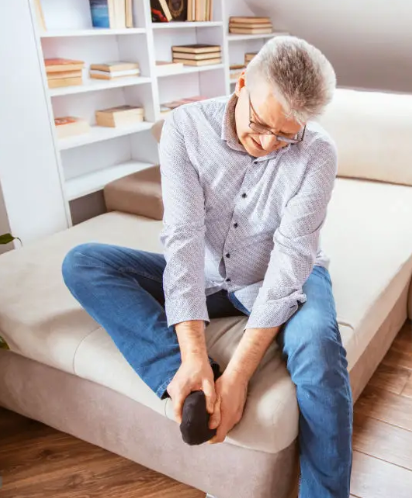Cure Plantar Fasciitis in one Week or Less
Plantar fasciitis, a common cause of heel pain, involves inflammation of the thick band of tissue (plantar fascia) that runs across the bottom of your foot and connects your heel bone to your toes. For anyone who’s ever suffered from plantar fasciitis, you know the pain all too well. The endless cycle of stretches and medications, the extreme measures like injections or even surgery. Speaking from personal experience, having battled with flat feet from a young age, I was no stranger to the repeat offense of plantar fasciitis. Relief once seemed quick and simple had now gotten worse with each flair-up. I went from being diagnosed one day and completely fine 2 days later, to getting a flair-up and being on crutches for almost 2 months.

Before we get too deep in the conversation, here is a list of the things you will want to have on hand to prepare yourself for your plantar fasciitis healing journey.
- Kinesiology tape or K-Tape
- Plantar Fasciitis Night Splint
- Plantar Fasciitis Day Splint
- Frozen Water Bottle
- Over-the-counter anti-inflammatory drugs or NSAIDS
Here are some tips that helped me improve my recovery time starting with the traditional treatments, including night splints and typical stretching methods. It was a journey filled with frustration until I realized all these treatments work together and with some determination using them all can rid your pain and get you back to normal life quickly.
Kinesiology tape or K-Tape for Plantar Fasciitis
K-tape won’t cure your plantar fasciitis but it will help put the arch of your foot into a correct position to help relieve the pain while you are in recovery mode. K-tape is recommend to be wrapped around your foot first thing in the morning. You can use it throughout the day and you will be able to tell a noticeable difference in comfort when walking while wearing k-tape.
K-tape is simple to use, and it sticks to your skin to help pull the arch of your foot up. You simply want to attach it to the bottom of your foot then pull the tape tight and let it stick to your leg. See the image below for example. K-tape is easy to remove and won’t harm your skin.

Plantar Fasciitis Frozen Water Bottle Technique
- Prepare a Frozen Water Bottle: Fill a water bottle with water and place it in the freezer until it’s completely frozen. A standard 16.9-ounce (500 ml) bottle works well, but any size that fits comfortably under your foot will do.
- Roll Your Foot: Sit down in a comfortable chair and place the frozen water bottle on the floor. Roll your foot over the bottle, applying gentle pressure. Start from the front of your heel and move towards your toes, covering the entire arch of your foot.
- Duration: Continue to roll your foot over the bottle for about 5 to 10 minutes. Perform this technique at least once a day, ideally in the morning to alleviate morning heel pain and again in the evening if needed.
Plantar Fasciitis Medications and Over-the-Counter (OTC) Pain Relievers
Nonsteroidal Anti-Inflammatory Drugs (NSAIDs): These are the most commonly recommended medications for plantar fasciitis to help reduce inflammation and alleviate pain. Examples include ibuprofen (Advil, Motrin IB) and naproxen sodium (Aleve). You can also get a stronger version of NSAID as a prescription from your doctor, however, these do have strong side effects and are only recommended when the pain is at a level that is not tolerable.
Plantar Fasciitis Foot Splints or Night Splints
A plantar fasciitis foot splint is a device designed to provide support and gentle stretching to the foot of individuals suffering from plantar fasciitis.

The primary goal of a plantar fasciitis foot splint is to stretch the plantar fascia gently and continuously. This stretching can help to:
- Reduce Inflammation by keeping the plantar fascia gently stretched, splints can help to reduce the inflammation that contributes to pain.
- Alleviate Pain with regular use to decrease the sharp pain felt in the morning or after periods of rest, often described as stepping on a nail.
- Promote Healing by preventing the plantar fascia from contracting and tightening overnight or during periods of inactivity, splints can aid in the healing process.
Types of Plantar Fasciitis Foot Splints
There are two main types of foot splints used for plantar fasciitis:
Night Splints: These are designed to be worn during sleep. Night splints keep the foot in a dorsiflexed position (toes pointed upwards) throughout the night. This position applies a constant, gentle stretch to the plantar fascia and Achilles tendon, helping to reduce the morning pain and stiffness commonly experienced by individuals with plantar fasciitis.
Day Splints or Orthotic Braces: These are more flexible and can be worn during the day, under socks and shoes. They are less bulky than night splints and provide support to the arch and plantar fascia during daily activities. However, they do not offer the same level of stretching as night splints.
Plantar Fasciitis Stretching Tips and Techniques
One turning point for plantar fasciitis pain came when I discovered a technique that went against everything I had been told about treating it. Instead of the usual stretches that target the inflamed area, this method focused on the opposite muscles. The results? Nothing short of miraculous. The pain that had been a constant companion began to fade, transforming despair into hope.
How to Start Your Journey Towards Relief:
- Get Comfortable: Sit down and cross your leg, placing the affected foot over your knee.
- The Right Stretch: Gently pull your foot downwards, focusing on the stretch in the opposite direction of the usual advice.
- Focus on the Front: This method targets the anterior tibialis muscle, located at the shin’s front, offering a new approach to relief.
- Repeat for Results: A series of ten stretches can lead to a significant decrease in pain.
This approach is based on the principle of reciprocal inhibition, where stretching one set of muscles sends a signal to relax the opposing set, thus easing the tension where it’s needed most. After completing the series of stretches, the difference in pain levels can be both surprising and immensely gratifying.
A New Perspective on Plantar Fasciitis
This journey has not only changed my relationship with plantar fasciitis but also challenged the prevailing wisdom on its treatment. It’s a testament to the body’s complexity and the potential for simple, targeted actions to bring about profound changes.
I share this story not just as a testament to my journey but as an invitation to those who continue to struggle with plantar fasciitis. There’s a path to relief that diverges from the conventional route, one that offers hope and tangible results. Together, we can step away from the pain and towards a future where plantar fasciitis no longer dictates our limits. Let’s walk this path of discovery and healing, one step at a time.
Please remember that with all of our articles, links to products are affiliate links so a very small percentage of sales will go to Daily Health and Wellness.


Leave a Reply